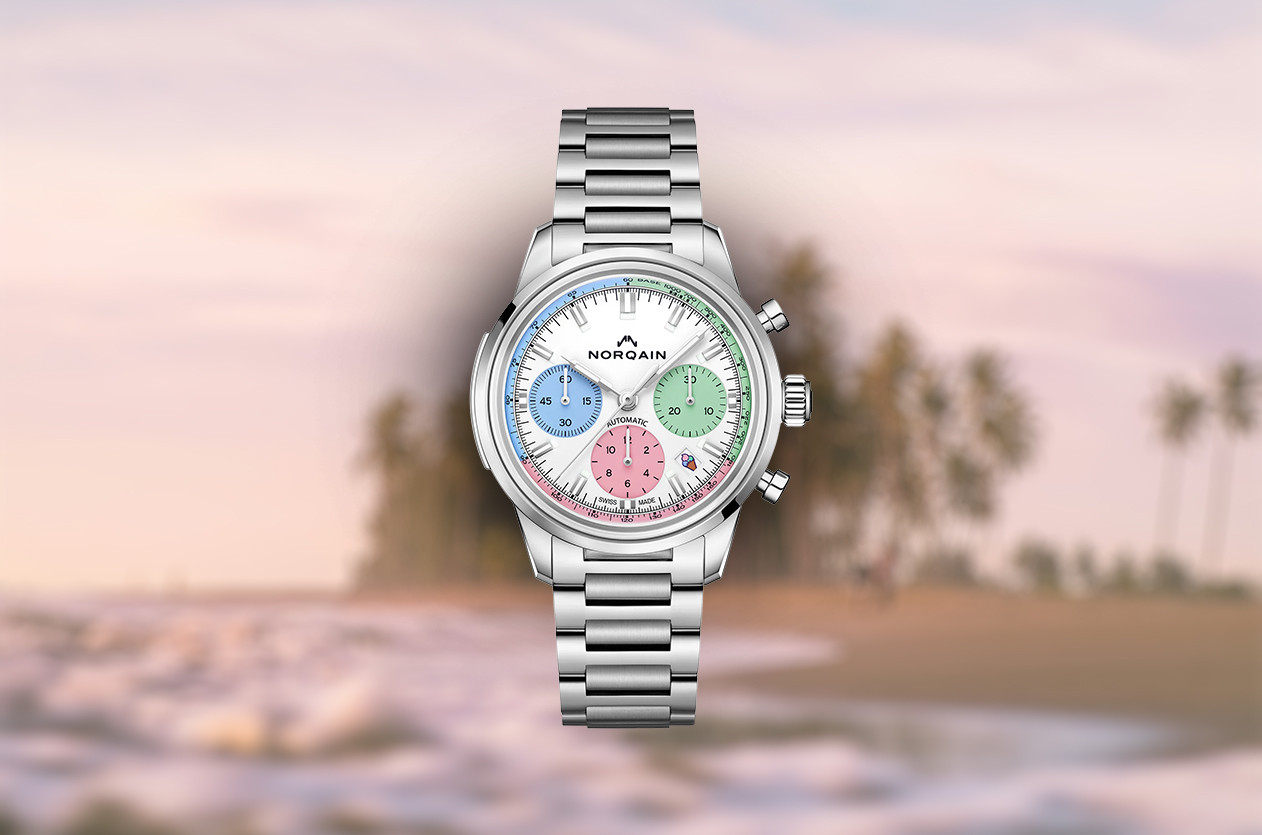
Introducing Norqain Unveils The Freedom 60 Chrono 40mm Enjoy Life
Welcome to the hub of the horoloy
Celebrating the Craftsmanship and Legacy of Classic Timepieces

Anticipation is always high as any auction of prestigious watches approaches, and Phillips' habit of displaying rare pieces with distinction gets a new stage at the Hong Kong Watch Auction XVIII. Scheduled to take place from May 24-25, 2024, this auction promises to showcase pieces that will impress watch enthusiasts.
As the Waqt team previously selected the watches that caught our attention, most of them were wristwatches, with the exception of the unique landfill watch from Cartier. However, the Phillips exhibits that stole the spotlight this time were the pocket watches presented by the house. We had to talk about them in a separate article due to their significance to enthusiasts and their historical importance in the watch industry.
Pocket watches have a captivating history that extends back centuries. They originated in the 16th century as status symbols and developed during the 17th and 18th centuries with advances in technology. The 19th century saw many innovations, making pocket watches more accessible and convenient for everyday use. By the early twentieth century, pocket watches were ubiquitous, gaining great popularity during World War I. Although their daily use has declined, pocket watches are still prized by collectors.
Pocket watches are mechanical pieces of art, each representing an example of the art of watchmaking. It’s time to select five pocket watches from the 18th Phillips Hong Kong Auction.
Patek Philippe 767

Patek Philippe’s first horological complication pocket watch with three complications emerged in the late 19th century. One notable example, part of the Patek Philippe Museum collection, is No. 47’721. This hunter case pink gold pocket watch features a minute repeater, a perpetual calendar, and a chronograph.

The hunter case was created to protect the fragile glass crystal and enamel dial of pocket watches. It featured a sturdy spring-hinged cover over the watch face. The name "hunter" came from England during the peak of fox hunting.
Powered by Piguet Freres movement. It was among the first pocket watches with an instantaneous calendar and was showcased at the 1876 Centennial International Exhibition in Philadelphia.
In 1950, Patek Philippe modernized the Triple Complication with the launch of reference 767. This model, known as the “Moderne” reference, featured an open-faced design with clean, elegant lines, prominent bows, and integrated crown guards. Measuring 50mm in diameter, most of these pocket watches were crafted by master Geneva watchmaker Antoine Gerlach. They utilized important movements from the 1920s, refurbished and cased in yellow gold after the 1950s, with unique dial variations including Arabic and baton hour markers.

Only seven examples of the ref. 767 have ever appeared publicly, underscoring its rarity. The present ref. 767 is the only known example with a double-split chronograph mechanism, featuring five hands on the central pinion: hour, minute, chronograph, and double-split hands, making it an exceptional collector's piece. The estimated price is $410,000 - 821,000 which is equivalent to 1,506,000 - 3,015,000 AED.
Patek Philippe 652/1

The Patek Philippe pocket watch reference 652/1 was introduced in 1937 and produced until 1994. To our knowledge, this is the only Cartier-signed Patek Philippe reference 652/1 pocket watch to appear publicly at auction.

The yellow gold case, crafted by Antoine Gerlach and marked with key number 4 on the inside caseback. The back cover features an intricate blue enamel coat of arms with the motto “Cari Deo Nihil Carent” (“Those dear to God want nothing”). The watch is powered by the rhodium-finished 18-jewel movement calibre 17-170, decorated with Fausses Côtes and stamped with the Geneva Seal. The "HOX" stamp on the main bridge indicates it was made for the American market.
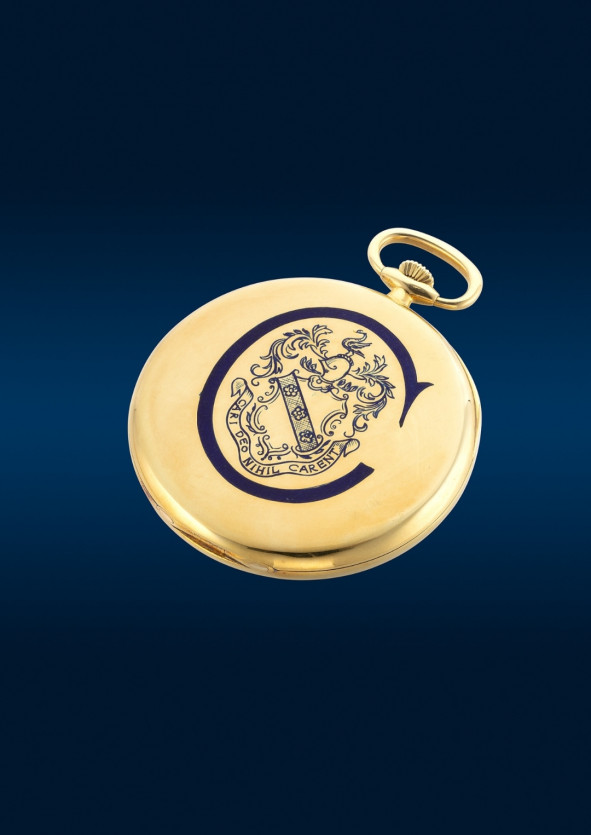
In excellent condition. It is double-signed by Patek Philippe and Cartier, featuring applied gold Breguet numerals with a lovely patina, leaf hands, and a minimalistic subsidiary dial with blue indices matching the blue enamel coat of arms. This refined and sophisticated timepiece is a superb example for discerning collectors. Estimated price $6,200 - 10,300 equivalent to 23,000 - 38,000 AED.
L. Leroy & Cie
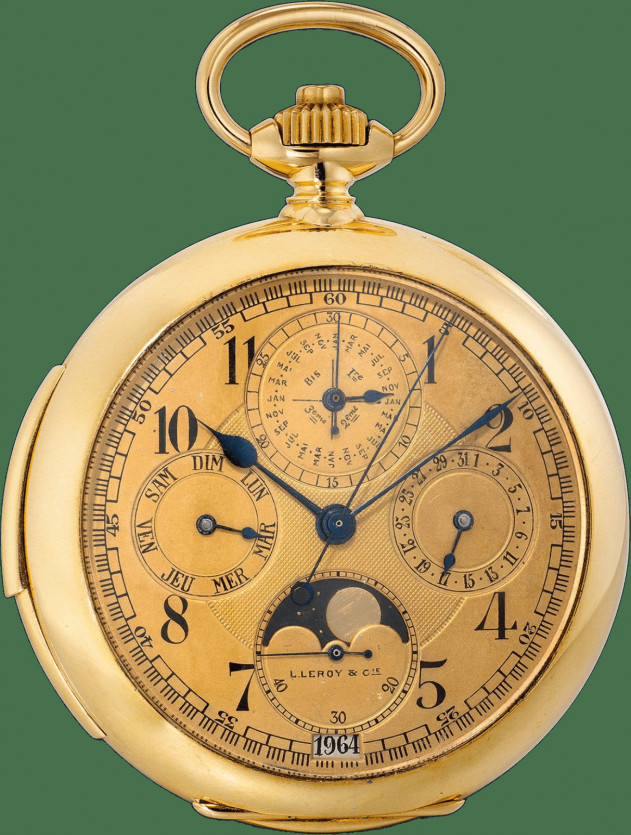
Louis Leroy, born in 1860, is often compared to Breguet for his aesthetic and technical innovations. In 1900, he created the Leroy 01, the most complicated watch of its time, boasting 24 complications on two dials. Beyond chiming features like the minute repeater and grande and petite sonnerie, the Leroy 01 displayed time in 125 cities, seasons, solstices, equinoxes, a perpetual calendar, a hygrometer, a barometer, and even an altimeter. It also featured three interchangeable celestial charts showing the skies over Paris, Lisbon, and Rio de Janeiro. The Leroy 01 remained the world’s most complicated timepiece until Patek Philippe's Caliber 89 in 1989.

Leroy's watchmaking expertise led to fruitful collaborations with esteemed observatories worldwide. On August 26, 1932, the present watch was submitted for rating at the Observatory of Besançon, achieving an impressive score of 169.35 points. It received a first-class rating, as indicated by the engraving on the cuvette and the prestigious viper's head hallmark stamped on the movement, denoting its certification by the Observatory of Besançon. Remarkably, it has been tested and stamped twice.

One might expect a chronometer-grade movement in a time-only watch, but this piece features an impressive minute repeating perpetual calendar chronograph movement, showcasing mechanical prowess from the 1930s. The engine-turned dial adds to its allure and is exceptionally well-balanced. Notably, it includes a rare digital year indication for 21 years at the 6 o'clock aperture. The year ring, starting from "1964," was replaced by the original owner 34 years after acquiring the watch, underscoring its continued excellence and historical significance.
The estimated price of this piece is $20,500 - 41,000 which is equivalent to 75,000 - 150,500 AED.
Audemars Piguet 25565BA.O.0000.01

The Audemars Piguet pocket watch presented here is a modern masterpiece celebrating the brand's 125th anniversary, evolving from a legacy of horological excellence since 1875. Released in 2000 as part of a limited series during a traveling exhibition showcasing 125 of the brand's creations, pocket watch has been privately owned since its creation.
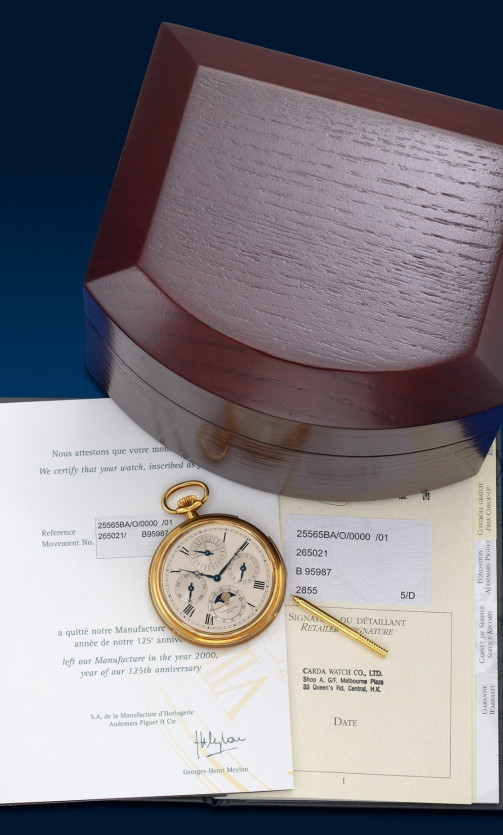
This yellow gold grand complication, is an exceptional minute repeating perpetual calendar pocket watch, reference 25565BA, is noted for its elegance and craftsmanship. It features a 50mm extra-flat case, Roman numerals, and sunken sub-dials, displaying information clearly with delicate typography. Numbered 10, it is in outstanding condition, with a rich patina from careful preservation.
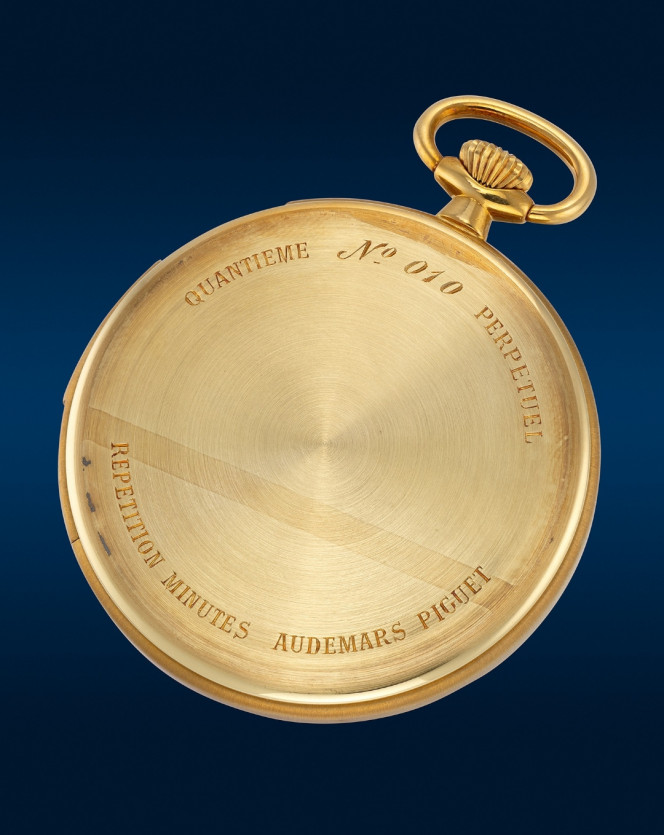
The watch chimes with excellent tone and clarity and comes as a complete set. This rare piece offers collectors a chance to own a horological masterpiece, with the proceeds from its sale being donated to various charities. The estimated price is $20,500 - 41,000 which is equivalent to 75,000 - 150,500 AED.
Charles Frodsham 08867
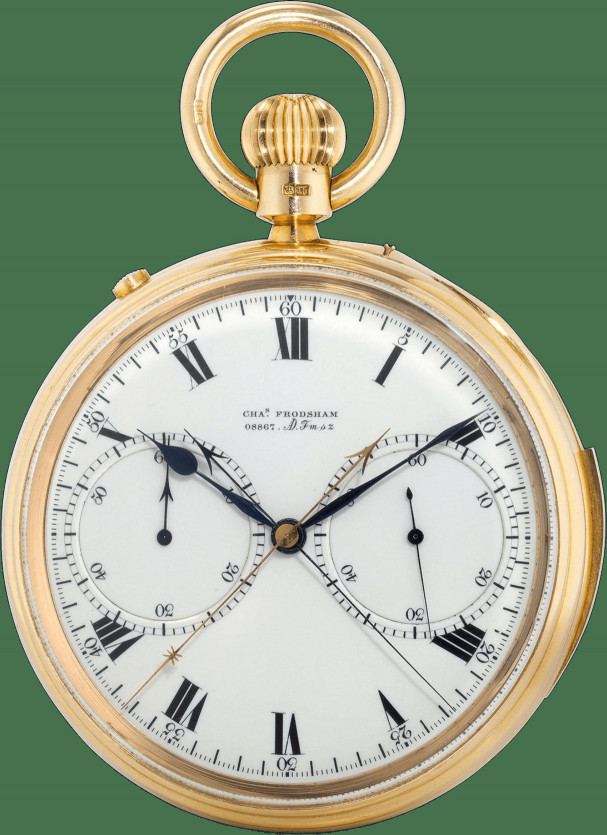
Charles Frodsham, a renowned English watchmaking firm since the late 19th century, was led by Charles Frodsham who became Superintendent and Keeper of Her Majesty's Clocks at Buckingham Palace in 1854. After Charles's death, his son Harrison Mill Frodsham took over, incorporating the firm as Charles Frodsham & Co. Ltd. in 1893. Harrison was a skilled horologist and businessman, ensuring the company's continued success.
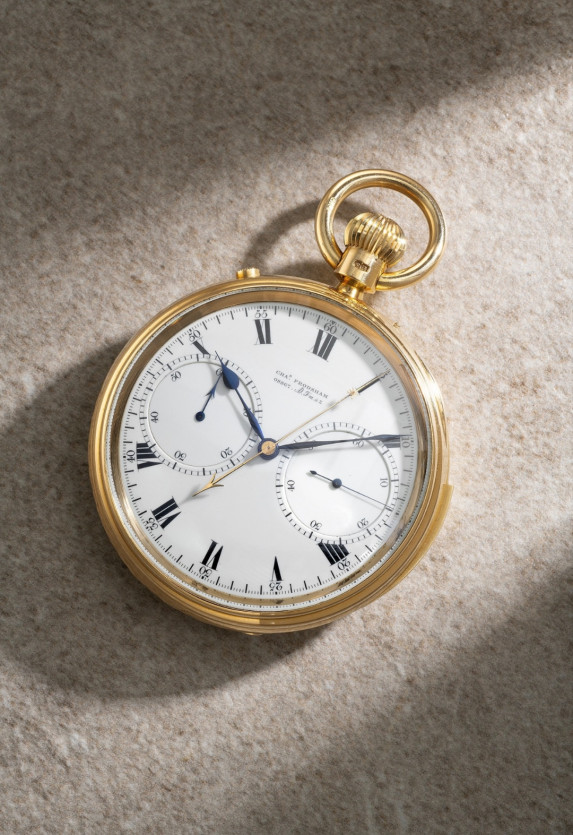
This particular piece is an exemplary Charles Frodsham tourbillon pocket watch, serial No. 08'867. Only 12 of these watches have resurfaced, with the rest in private collections or with original owners' descendants. The watch features a minute repeater, split-seconds chronograph, and a one-minute tourbillon, noted for its intricate and expensive design, originally selling for £200-£350.

The watch is in excellent condition, with a 63 mm stepped case, unrubbed hallmarks, and a pristine enamel dial. Many Frodsham watches bear the coded "AD Fmsz," indicating 1850, a mark of high quality. The inner caseback has hallmarks from the London Assay Office, 18-carat gold, the year 1901, and "HMF" for Harrison Mill Frodsham. The movement is engraved with the Charles Frodsham address at "115 New Bond Street, Late of 84 Strand."
In 1902, this watch was tested at Kew Observatory, earning an A certificate with 78.4 marks. It has been part of a prominent family collection for nearly 30 years.
The estimated price of this watch is $61,500 - 123,000 equivalent to 226,000 - 452,000 AED.
For more information please visit Phillips official website.

Introducing URWERK Unveils Its Latest Creation: The UR-150 Scorpion

Editorial De Bethune, Pioneering Innovation Through Time

Introducing Daniel Roth Unveils New Tourbillon Souscription

Auction F.P. Journe Wins the Battle for a Breguet Legend

Introducing The S3 Deadbeat Seconds Power Reserve from Garrick

Editorial U.S. Tariffs and the Dollar Rate, A New Challenge for the Swiss Watch Industry

News Dubai Watch Week 2025 Will Be the Largest Ever with 90 Brands Participating

Auction Phillips Achieves CHF 43.4 Million at the Geneva Watch Auction XXI

Technical The Frequency, Why It Matters in Mechanical Watches

Editorial Exploring the Distinctive Charm of Regulator Watches

Summary Manuel Emch, Waqt’s Personality of the Year 2024
Comment Delete Text
This page is available in English only. Please click below to visit Arabic Home page!